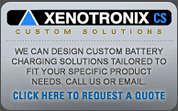Glossary for frequently used terms
Use the navigation links below to search for terms used in this site.
![]()
L
![]()
Lead-acid battery
An electrical storage device that uses a reversible chemical reaction to store energy using a combination of lead or lead-alloy plates or grids and an electrolyte consisting of a diluted sulfuric acid to convert electrical energy into chemical energy and back again. The nominal cell voltage is 2.0 volts.
Linear Power Supply
A type of power supply that regulates power by adjusting the series resistance of the circuit, burning off excess power as heat. A linear supply is less efficient than a Switch Mode Power Supply (SMPS), requiring more input power for a given output power. The power losses require more heat sinking, and (when operating from line-voltage) a large heavy transformer is required for isolation. However, linear supplies are simpler that an SMPS, and are easier to keep within emissions regulations. Linear supplies are particularly attractive for certain medical applications, as the emissions filter of an SMPS can often have unacceptable ground leakage.
Liquid Electrolyte Battery
See Flooded Battery.
Lithium-Ion Battery (Li-ion, Li+)
A type of rechargeable battery made with Lithium ions from chemicals (Lithium is an unstable metal). There are many different materials used in the construction of Li-ion batteries. Lithium-ion is a low maintenance battery, an advantage that most other chemistries cannot claim. They are currently one of the most popular types of battery, with one of the best energy-to-weight ratios, no memory effect and a slow loss of charge when not in use. The high nominal cell voltage of 3.6 volts allows battery pack designs with only one cell (some are 3.7V and some 3.8V, depending on materials).
Lithium Polymer Battery
Similar to lithium-ion batteries but with a solid electrolyte and can be formed into nearly any shape. Some gelled conductive material may be added to promote conductivity. Typically can withstand and prefers higher ambient temperatures.
Low Maintenance Battery
A flooded lead-acid battery that requires the addition of water to maintain the electrolyte level, but less often than for standard flooded lead-acid batteries.



